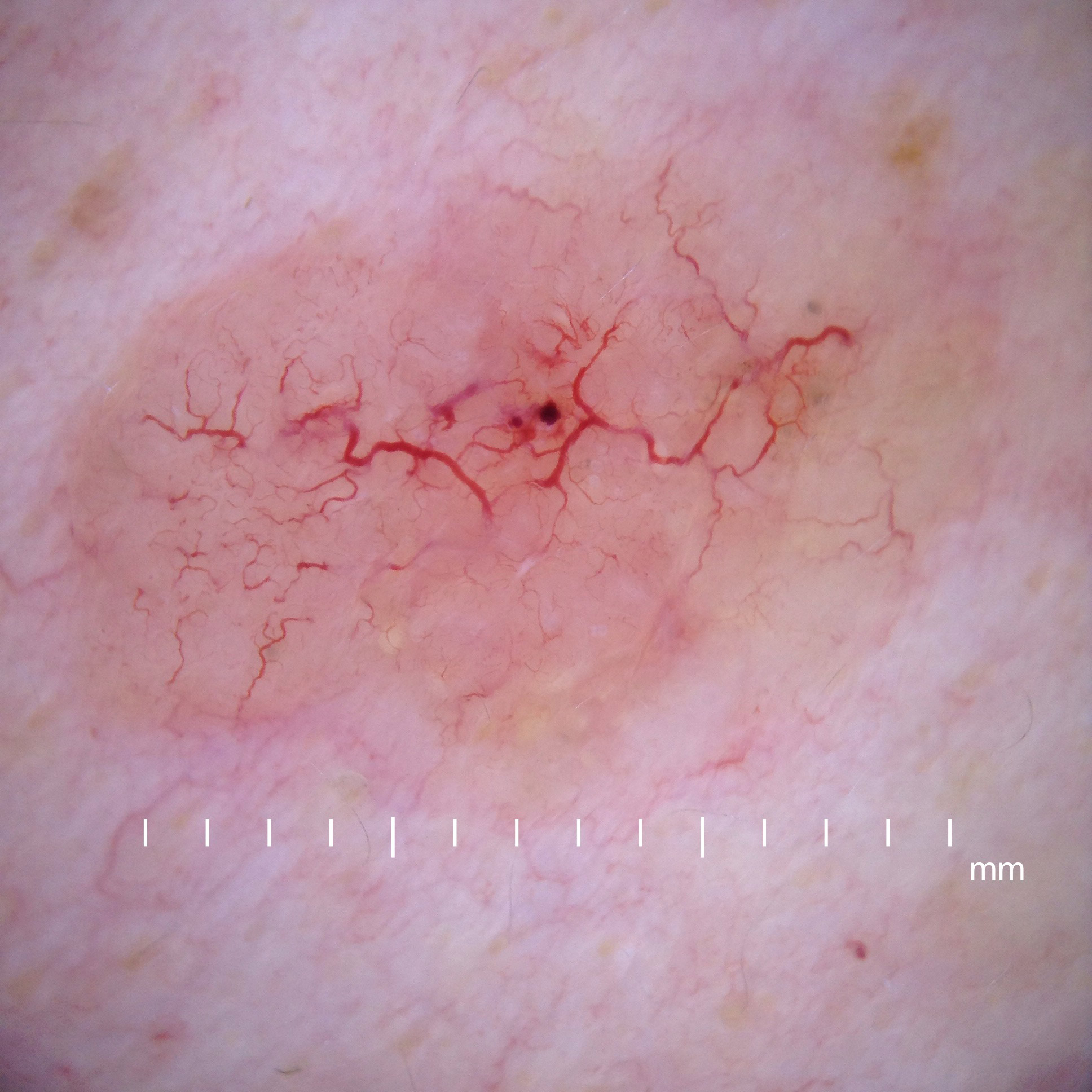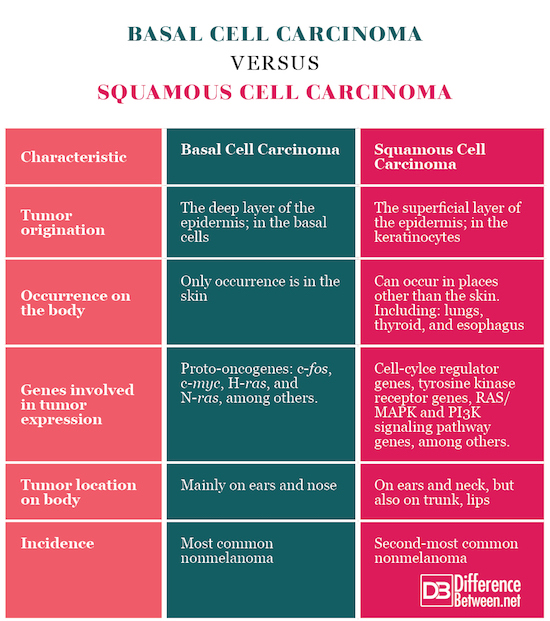Difference Between Basal Cell and Squamous Cell Carcinoma
Cancer or carcinoma, the abnormal growth of cells, can affect any number of human organs and tissues. Skin cancer is cancer that occurs in skin cells. There are three types of skin cancer, but two main types of the three: basal cell carcinoma and squamous cell carcinoma.
Basal cell carcinomas are the most common type of skin cancer. Basal cell carcinoma grows slowly and can damage tissue but it is unlikely to be deadly or metastasize (spread) to other parts of the body.
Squamous cell carcinomas also onset over a long period of time, on the scale of several months, and it is more likely to metastasize than basal cell carcinoma. Squamous cell carcinomas are also not limited to the skin, and can occur in places like the lungs, thyroid, and esophagus.
Basal cell carcinomas have many causes, including long-term sun exposure and intense, extended sun exposure that leads to sunburn. These cancers occur in places that are exposed to the sun more frequently: ears, nose, scalp, shoulders and back. Other, less common causes of basal cell carcinomas include radiation exposure, chronic inflammation of the skin, burn complications and scarring.
Squamous cell carcinomas also have many causes, including but not limited to: extended exposure to sun or intense exposure to sun, extended UV radiation exposure, arsenic and other cancer-causing chemical exposure, tobacco use, and even being diagnosed with actinic keratoses (a precancerous skin damage condition).

What is Basal Cell Carcinoma?
Of the nonmelanoma skin cancers, more than 75% are basal cell carcinomas. Basal cell carcinomas are known to be one of the most malignant diseases that humans acquire in their lifetime. Basal cell carcinomas occur in a type of cell in the skin that produces new skin cells when other, older skin cells die.
In a clinical setting, it has been found that more than 99% of people who are diagnosed with basal cell carcinomas are white, usually between the ages of 40 and 79 years. In addition, more than half of these diagnoses are men.
When analyzing the histology of these cancers, the structure of these carcinomas can be broken down into the following sub-types: 50-54% nodular (solid tissue just under the skin), 9-11% superficial (in region around the dermal papillae), 4-8% cystic (growth of cysts), 1-7% adenoid (in glands), 6% pigmented (colored), 2% morpheaform (white plaques present), and 1% metatypical (a greater chance of metastasis).
The risk for recurrence of basal cell carcinomas depends on the location, type as determined by histology, and size of the tumor reported. For instance, basal cell carcinomas that occur on the nose or ear are more likely to recur, including morpheaform and metatypical tumors. Morpheaform tumors have certain characteristics about their biology that allows for more aggressive tumor formation and stability, including increased actin filaments, decreased amyloid formation (thus making it harder for tumors to be broken down), and increased collagen synthesis.
Clinical and biological markers of basal cell carcinomas are defined as:
- Occurring in the basal cells of the epidermis
- More invasive basal cell carcinomas have increased production of type IV collagenase, actin microfilaments, and tetraploid DNA, among other characteristics
- Slow growing, averaging cell cycles around 217 hours
- Slight aneuploidy of DNA in cells (~19% of samples)
- Rare metastatic incidence

What is Squamous Cell Carcinoma?
Squamous cell carcinomas are a cancer of the skin (and other parts of the body) that are characterized by malignant tumors that develop in epithelial keratinocytes, or the cells that produce keratin. It is the second most common skin cancer within the white population, with basal cell carcinoma being the first most common skin cancer. Squamous cell carcinoma incidence has grown by 50 to 200% over the past 10 to 30 years, based on various studies. Squamous cell carcinomas are also geographically-dependent in populations of which it affects: for instance, there is a 50-fold increase in rates when comparing Northern Europe to Australia.
Squamous cell carcinomas are similar to basal cell carcinomas in that they are both cancers of the skin. However, squamous cell carcinomas can occur in other parts of the body and organs. Both carcinomas are characterized by their presence in specific skin cells, though they do occur at different layers of the skin: basal cells are in the lower part of the epidermis, whereas squamous cells are closer to the surface of the epidermis.
Squamous cell carcinoma-diagnosed patients usually have tumors on sun-exposed areas that are often in the form of firm nodules, which can be small. Squamous cell carcinomas lack translucence, unlike basal cell carcinoma tumors.
Clinical and biological markers of squamous cell carcinomas are defined as:
- Occurring in the squamous (surface) keratinocytes of the epidermis
- Inactivation of multiple tumor suppressor genes and activation of proto-oncogenes which leads to a higher incidence of tumors
- Slow growing
- Invasive tumors result in firm papules or plaques that are pink or skin-colored
- More likely than basal cell carcinomas to metastasize, but still rare
Difference Between Basal Cell and Squamous Cell Carcinoma
-
Cause of tumor formation
Basal cell carcinoma tumors form from exposure to the sun, whereas squamous cell carcinoma tumors can form from exposure to the sun, HPV exposure, immunosuppression, and chemical exposure.
-
Location of tumors
Basal cell carcinoma tumors form mostly in areas that are exposed to sun, primarily on the nose and ears. Squamous cell carcinoma tumors form particularly on the ears, but can also occur on the trunk and neck.
-
Biology of tumors
Basal cell carcinoma tumors are characterized with an increase in proto-oncogene expression of c-fos, c-myc, H-ras, and N-ras, among other genes. Squamous cell carcinoma tumors have a high mutation rate in TP53 and CDKN2A/RB1 genes, among other genes.
-
Layer of epidermis affected
A majority of basal cell carcinomas originate in the basal layer of the epidermis, in basal cells. A majority of squamous cell carcinomas originate in the more superficial squamous layer of the epidermis, in the keratinocytes.
-
Incidence in population
Basal cell carcinomas are the most common type of nonmelanoma skin cancer, while squamous cell carcinomas are the second-most common type of nonmelanoma skin cancer.
Basal Cell vs. Squamous Cell Carcinoma: Comparison Table

Summary of Basal Cell versus Squamous Cell Carcinoma
- Basal cell and squamous cell carcinomas are both types of skin cancers.
- Basal cell carcinoma is primarily a skin cancer, whereas squamous cell carcinomas can occur in other organs and tissue types.
- Basal cell carcinoma tumors are more translucent in character than squamous cell carcinoma tumors. Basal cell carcinoma tumors can also have many pigmentations about them, and are most likely to be nodular. Squamous cell carcinoma tumors are also nodular in nature.
- Both types of skin cancers are rarely metastatic, but squamous cell carcinomas are more likely than basal cell carcinomas to be metastatic.
- Basal cell carcinomas are the most common form of nonmelanomas, with squamous cell carcinomas coming in second.
- Difference Between Basal Cell and Squamous Cell Carcinoma - July 12, 2018
- Difference Between Hepatitis and Cirrhosis - May 22, 2018
- Difference Between Reversible and Irreversible Cell Injury - May 12, 2018
Search DifferenceBetween.net :
Leave a Response
References :
[0]Dotto, G. Paolo, and Anil K. Rustgi. "Squamous cell cancers: a unified perspective on biology and genetics." Cancer cell29.5 (2016): 622-637.
[1]Miller, Stanley J. "Biology of basal cell carcinoma (Part I)." Journal of the American Academy of Dermatology 24.1 (1991): 1-13.
[2]Schwartz, Robert A. "Squamous cell carcinoma." Skin Cancer. Springer, New York, NY, 1988. 36-47.
[3]Image credit: https://upload.wikimedia.org/wikipedia/commons/thumb/5/5e/Oral_cancer_%281%29_squamous_cell_carcinoma_histopathology.jpg/638px-Oral_cancer_%281%29_squamous_cell_carcinoma_histopathology.jpg
[4]Image credit: https://en.wikipedia.org/wiki/Basal-cell_carcinoma#/media/File:Dermoscopy_nodular_basal_cell_carcinoma.jpg
